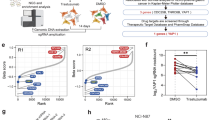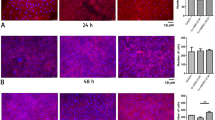Abstract
Myxofibrosarcoma is genetically complex and lacks effective nonsurgical treatment strategies; thus, elucidation of novel molecular drivers is urgently needed. Reanalyzing public myxofibrosarcoma datasets, we identified mRNA upregulation and recurrent gain of RSF1 and characterized this chromatin remodeling gene. Myxofibrosarcoma cell lines were employed to elucidate the oncogenic mechanisms of RSF1 by genetic manipulation and two IL-1β-neutralizing antibodies (RD24, P2D7KK), highlighting the regulatory basis and targetability of downstream IL-1β-mediated angiogenesis. Tumor samples were assessed for RSF1, IL-1β, and microvascular density (MVD) by immunohistochemistry and for RSF1 gene status by FISH. In vivo, RSF1-silenced and P2D7KK-treated xenografts were analyzed for tumor-promoting effects and the IL-1β-linked therapeutic relevance of RSF1, respectively. In vitro, RSF1 overexpression promoted invasive and angiogenic phenotypes with a stronger proangiogenic effect. RT-PCR profiling identified IL1B as a top-ranking candidate upregulated by RSF1. RSF1 required hSNF2H and CEBP/β to cotransactivate the IL1B promoter, which increased the IL1B mRNA level, IL-1β secretion and angiogenic capacity. Angiogenesis induced by RSF1-upregulated IL-1β was counteracted by IL1B knockdown and both IL-1β-neutralizing antibodies. Clinically, RSF1 overexpression was highly associated with RSF1 amplification, IL-1β overexpression, increased MVD and higher grades (all P ≤ 0.01) and independently predicted shorter disease-specific survival (P = 0.019, hazard ratio: 4.556). In vivo, both RSF1 knockdown and anti-IL-1β P2D7KK (200 μg twice weekly) enabled significant growth inhibition and devascularization in xenografts. In conclusion, RSF1 overexpression, partly attributable to RSF1 amplification, contributes a novel proangiogenic function by partnering with CEBP/β to cotransactivate IL1B, highlighting its prognostic, pathogenetic, and therapeutic relevance in myxofibrosarcomas.






Similar content being viewed by others
References
Huang HY, Mentzel TDW, Shibata T (2020) Myxofiborsarcoma. WHO classification of tumors: soft tissue and bone tumours, 5th edn. IARC Publication, Lyon Cedex, pp 124–126
Haglund KE, Raut CP, Nascimento AF, Wang Q, George S, Baldini EH (2012) Recurrence patterns and survival for patients with intermediate- and high-grade myxofibrosarcoma. Int J Radiat Oncol Biol Phys 82(1):361–367
Huang HY, Lal P, Qin J, Brennan MF, Antonescu CR (2004) Low-grade myxofibrosarcoma: a clinicopathologic analysis of 49 cases treated at a single institution with simultaneous assessment of the efficacy of 3-tier and 4-tier grading systems. Hum Pathol 35(5):612–621
Roland CL, Wang WL, Lazar AJ, Torres KE (2016) Myxofibrosarcoma. Surg Oncol Clin N Am 25(4):775–788
Sanfilippo R, Miceli R, Grosso F, Fiore M, Puma E, Pennacchioli E et al (2011) Myxofibrosarcoma: prognostic factors and survival in a series of patients treated at a single institution. Ann Surg Oncol 18(3):720–725
Barretina J, Taylor BS, Banerji S, Ramos AH, Lagos-Quintana M, Decarolis PL et al (2010) Subtype-specific genomic alterations define new targets for soft-tissue sarcoma therapy. Nat Genet 42(8):715–721
Huang HY, Wu WR, Wang YH, Wang JW, Fang FM, Tsai JW et al (2013) ASS1 as a novel tumor suppressor gene in myxofibrosarcomas: aberrant loss via epigenetic DNA methylation confers aggressive phenotypes, negative prognostic impact, and therapeutic relevance. Clin Cancer Res 19(11):2861–2872
Li CF, Fang FM, Lan J, Wang JW, Kung HJ, Chen LT et al (2014) AMACR amplification in myxofibrosarcomas: a mechanism of overexpression that promotes cell proliferation with therapeutic relevance. Clin Cancer Res 20(23):6141–6152
Li CF, Wang JM, Kang HY, Huang CK, Wang JW, Fang FM et al (2012) Characterization of gene amplification-driven SKP2 overexpression in myxofibrosarcoma: potential implications in tumor progression and therapeutics. Clin Cancer Res 18(6):1598–1610
Okada T, Lee AY, Qin LX, Agaram N, Mimae T, Shen Y (2016) Integrin-α10 dependency identifies RAC and RICTOR as therapeutic targets in high-grade myxofibrosarcoma. Cancer Discov 6(10):1148–1165
Tsai JW, Li CF, Kao YC, Wang JW, Fang FM, Wang YH et al (2012) Recurrent amplification at 7q21.2 Targets CDK6 gene in primary myxofibrosarcomas and identifies CDK6 overexpression as an independent adverse prognosticator. Ann Surg Oncol 19(8):2716–2725
Aydin ÖZ, Vermeulen W, Lans H (2014) ISWI chromatin remodeling complexes in the DNA damage response. Cell Cycle 13(19):3016–3025
Helfricht A, van Attikum H (2014) Remodeling and spacing factor 1 (RSF1): a rising star in DNA repair. Epigenomics 6(3):261–265
Witkowski L, Foulkes WD (2015) In Brief: picturing the complex world of chromatin remodelling families. J Pathol 237(4):403–406
Agaimy A, Foulkes WD (2018) Hereditary SWI/SNF complex deficiency syndromes. Semin Diagn Pathol 35(3):193–198
Masliah-Planchon J, Bièche I, Guinebretière JM, Bourdeaut F, Delattre O (2015) SWI/SNF chromatin remodeling and human malignancies. Annu Rev Pathol 10:145–171
Schaefer IM, Hornick JL (2020) SWI/SNF complex-deficient soft tissue neoplasms: an update. Semin Diagn Pathol. https://doi.org/10.1053/j.semdp.2020.05.005
Lazar AJ, McLellan MD, Bailey MH, Miller CA, Appelbaum EL, Cordes MG, Fronick CC, Fulton LA, Fulton RS, Mardis ER, Schmidt HK (2017) Comprehensive and integrated genomic characterization of adult soft tissue sarcomas. Cell 171(4):950–65.e28
Cerami E, Gao J, Dogrusoz U, Gross BE, Sumer SO, Aksoy BA et al (2012) The cBio cancer genomics portal: an open platform for exploring multidimensional cancer genomics data. Cancer Discov 2(5):401–404
Shih Ie M, Sheu JJ, Santillan A, Nakayama K, Yen MJ, Bristow RE et al (2005) Amplification of a chromatin remodeling gene, Rsf-1/HBXAP, in ovarian carcinoma. Proc Natl Acad Sci USA 102(39):14004–14009
Li CF, Liu TT, Wang JC, Yu SC, Chen YY, Fang FM et al (2018) ydroxysteroid 11-beta dehydrogenase 1 overexpression with copy-number gain and missense mutations in primary gastrointestinal stromal tumors. J Clin Med 7(11):408
Kather JN, Marx A, Reyes-Aldasoro CC, Schad LR, Zöllner FG, Weis CA (2015) Continuous representation of tumor microvessel density and detection of angiogenic hotspots in histological whole-slide images. Oncotarget 6(22):19163–19176
Goh AX, Bertin-Maghit S, Ping Yeo S, Ho AW, Derks H, Mortellaro A et al (2014) A novel human anti-interleukin-1β neutralizing monoclonal antibody showing in vivo efficacy. mAbs 6(3):765–773
Voronov E, Carmi Y, Apte RN (2014) The role IL-1 in tumor-mediated angiogenesis. Front Physiol 5:114
Basak C, Pathak SK, Bhattacharyya A, Mandal D, Pathak S, Kundu M (2005) NF-kappaB- and C/EBPbeta-driven interleukin-1beta gene expression and PAK1-mediated caspase-1 activation play essential roles in interleukin-1beta release from Helicobacter pylori lipopolysaccharide-stimulated macrophages. J Biol Chem 280(6):4279–4288
Steinberg XP, Hepp MI, Fernández García Y, Suganuma T, Swanson SK, Washburn M et al (2012) Human CCAAT/enhancer-binding protein β interacts with chromatin remodeling complexes of the imitation switch subfamily. Biochemistry 51(5):952–962
Li GZ, Okada T, Kim YM, Agaram NP, Sanchez-Vega F, Shen Y et al (2020) Rb and p53-deficient myxofibrosarcoma and undifferentiated pleomorphic sarcoma require Skp2 for survival. Cancer Res 80(12):2461–2471
Widemann BC, Italiano A (2018) Biology and management of undifferentiated pleomorphic sarcoma, myxofibrosarcoma, and malignant peripheral nerve sheath tumors: state of the art and perspectives. J Clin Oncol 36(2):160–167
Ogura K, Hosoda F, Arai Y, Nakamura H, Hama N, Totoki Y et al (2018) Integrated genetic and epigenetic analysis of myxofibrosarcoma. Nat Commun 9(1):2765
Sheu JJ, Choi JH, Guan B, Tsai FJ, Hua CH, Lai MT et al (2013) Rsf-1, a chromatin remodelling protein, interacts with cyclin E1 and promotes tumour development. J Pathol 229(4):559–568
Sheu JJ, Guan B, Choi JH, Lin A, Lee CH, Hsiao YT et al (2010) Rsf-1, a chromatin remodeling protein, induces DNA damage and promotes genomic instability. J Biol Chem 285(49):38260–38269
Wu D, Nie X, Ma C, Liu X, Liang X, An Y et al (2017) RSF1 functions as an oncogene in osteosarcoma and is regulated by XIST/miR-193a-3p axis. Biomed Pharmacother 95:207–214
Zhang X, Fu L, Xue D, Zhang X, Hao F, Xie L et al (2017) Overexpression of Rsf-1 correlates with poor survival and promotes invasion in non-small cell lung cancer. Virchows Arch 470(5):553–560
Chen TJ, Huang SC, Huang HY, Wei YC, Li CF (2011) Rsf-1/HBXAP overexpression is associated with disease-specific survival of patients with gallbladder carcinoma. APMIS 119(11):808–814
Fang FM, Li CF, Huang HY, Lai MT, Chen CM, Chiu IW et al (2011) Overexpression of a chromatin remodeling factor, RSF-1/HBXAP, correlates with aggressive oral squamous cell carcinoma. Am J Pathol 178(5):2407–2415
Höflmayer D, Hamuda M, Schroeder C, Hube-Magg C, Simon R, Göbel C et al (2020) High RSF1 protein expression is an independent prognostic feature in prostate cancer. Acta Oncol 59(3):268–273
Tai HC, Huang HY, Lee SW, Lin CY, Sheu MJ, Chang SL et al (2012) Associations of Rsf-1 overexpression with poor therapeutic response and worse survival in patients with nasopharyngeal carcinoma. J Clin Pathol 65(3):248–253
Dong Z, Liu H, Zhao G (2020) Long noncoding RNA SNHG6 promotes proliferation and inhibits apoptosis in non-small cell lung cancer cells by regulating miR-490-3p/RSF1 Axis. Cancer Biother Radiopharm 35(5):351–361
Zhao X, Ji Z, Xie Y, Liu G, Li H (2017) MicroRNA-154 as a prognostic factor in bladder cancer inhibits cellular malignancy by targeting RSF1 and RUNX2. Oncol Rep 38(5):2727–2734
Min S, Choi YW, Yun H, Jo S, Ji JH, Cho H (2018) Post-translational regulation of the RSF1 chromatin remodeler under DNA damage. Mol Cells 41(2):127–133
Shamay M, Barak O, Doitsh G, Ben-Dor I, Shaul Y (2002) Hepatitis B virus pX interacts with HBXAP, a PHD finger protein to coactivate transcription. J Biol Chem 277(12):9982–9988
Shamay M, Barak O, Shaul Y (2002) HBXAP, a novel PHD-finger protein, possesses transcription repression activity. Genomics 79(4):523–529
Carmi Y, Dotan S, Rider P, Kaplanov I, White MR, Baron R et al (2013) The role of IL-1β in the early tumor cell-induced angiogenic response. J Immunol 190(7):3500–3509
Das S, Shapiro B, Vucic EA, Vogt S, Bar-Sagi D (2020) Tumor cell-derived IL1β promotes desmoplasia and immune suppression in pancreatic cancer. Cancer Res 80(5):1088–1101
Resende C, Regalo G, Durães C, Pinto MT, Wen X, Figueiredo C et al (2016) Interleukin-1B signalling leads to increased survival of gastric carcinoma cells through a CREB-C/EBPβ-associated mechanism. Gastr Cancer 19(1):74–84
Tulotta C, Lefley DV, Freeman K, Gregory WM, Hanby AM, Heath PR et al (2019) Endogenous production of IL1B by breast cancer cells drives metastasis and colonization of the bone microenvironment. Clin Cancer Res 25(9):2769–2782
Acknowledgements
The authors thank Kaohsiung Chang Gung genomic (CLRPG8G0593) and tissue bank (CLRPG810032) core laboratories for technical assistance. The authors also thank Bioresource Collection and Research Center, Food Industry Research and Development Institute for the authentication of myxofibrosarcoma cell lines.
Funding
This work was sponsored by Taiwan National Ministry of Science and Technology (108-2320-B-182A-017-MY3 to HY Huang), Chang Gung Hospital (CMRPG8G0881, CMRPG8G0882 to HY Huang) and Ministry of Health and Welfare (MOHW104-TDU-M-212-133004 and 101-2320-B-384-001-MY3 to CF Li).
Author information
Authors and Affiliations
Contributions
Conception and design: CFL, HYH. Development of methodology: CFL, TCC, CIW, HYH. Acquisition, interpretation and analysis of the data: CFL, TCC, CIW, FMF, PCL, SCY, HYH. Writing, review, and/or revision of the manuscript: CFL, CIW, HYH. Study supervision: CFL, HYH. All authors had final approval of the submitted manuscript.
Corresponding author
Ethics declarations
Conflict of interest
H.Y. Huang reports receiving other research support from Bayer. No conflicts of interest are declared by other authors.
Ethical approval
The Chang Gung institutional review board approved the use of formalin-fixed tumor tissues under anonymous processing with a waiver of informed consent for this study (201701067B0).
Additional information
Publisher's Note
Springer Nature remains neutral with regard to jurisdictional claims in published maps and institutional affiliations.
Supplementary information
Below is the link to the electronic supplementary material.
Rights and permissions
About this article
Cite this article
Li, CF., Chan, TC., Wang, CI. et al. RSF1 requires CEBP/β and hSNF2H to promote IL-1β-mediated angiogenesis: the clinical and therapeutic relevance of RSF1 overexpression and amplification in myxofibrosarcomas. Angiogenesis 24, 533–548 (2021). https://doi.org/10.1007/s10456-020-09764-4
Received:
Accepted:
Published:
Issue Date:
DOI: https://doi.org/10.1007/s10456-020-09764-4




